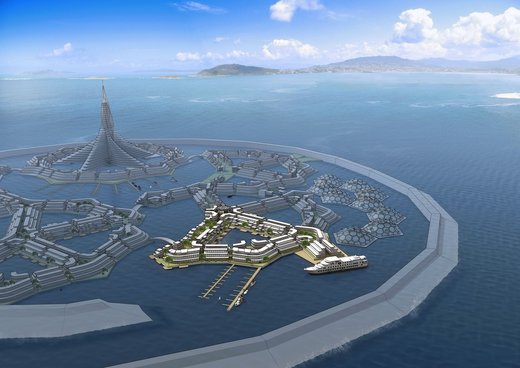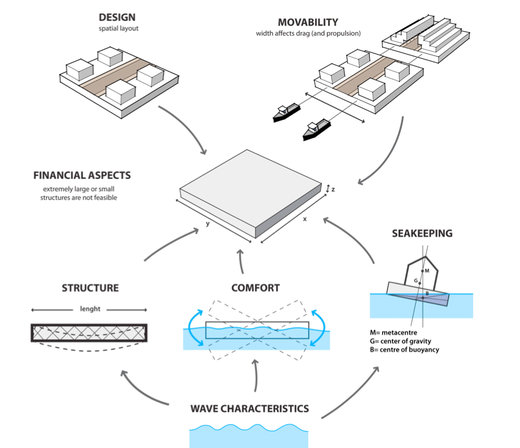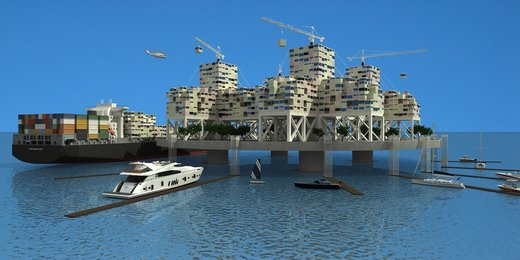15 April 2014
An American organisation is leading a movement to develop sovereign city states that float on the high seas – the goal being to experiment with new forms of government and to allow business people to escape the laws and taxes of land-based countries.
The California-based Seasteading Institute (“seasteading”, as in homesteading at sea), founded in 2008 by Patri Friedman, grandson of Nobel-winning free-market economist Milton Friedman and PayPal co-founder Peter Thiel, has commissioned a concept study from new Dutch marine design firm, DeltaSync.
That report proposes clusters of floating platforms, each 50m x 50m in area and kitted out with homes, commercial buildings and green spaces for paying “seasteaders”.
The institute is now polling potential floating property buyers and business owners to gauge demand for the concept, while raising cash for a detailed feasibility study and searching for an offshore location for the first seastead.
A bunch of tax avoiders?
The institute’s ultimate goal is to have autonomous city states floating beyond the jurisdiction of countries. These “startup governments” will make their own laws to suit residents and will help humanity by introducing competition in the world’s “governance market”.

Artist’s conception of a grown-up seastead with the floating breakwater necessary for the high seas (Seasteading Institute)
The institute believes seasteads are the way to go because reforming politics is just too difficult.
“Why not reform existing political systems?” the institute asks itself on its FAQ page.
The answer: “It is extremely difficult and costly to significantly impact political outcomes. Brand new political systems are generally the result of violent revolutions or coups, which are undesirable for obvious reasons.”
Seasteading allows a fresh, peaceful start, the institute says.
But for whom? Will seasteaders be a bunch of rich guys wanting to avoid taxes? The institute admits that lower taxes will be a draw for entrepreneurs, and that business will be a key ingredient, but denies that wealth accumulation is the prime motive. Poor people wanting to escape oppression could be seasteaders as well, it claims.
The structures
With $27,000 obtained through crowdfunding, the institute has commissioned Dutch design firm DeltaSync to put more flesh on the bones of the physical concept.
DeltaSync formed after a group of civil engineering and architecture students from Delft University of Technology won a competition sponsored by Dutch engineers Royal Haskoning with their design for a floating city on a lake near Amsterdam, in 2006.

Square and pentagonal concrete caisson hulls, 50m x 50m in area, are proposed as the basic physical unit of the floating city (DeltaSync)
The concept report, released in December, proposed a 50m x 50m floating platform made of a concrete caisson as the basic physical unit of the seastead.
Two shapes are suggested, one square and one pentagonal, because the pentagon would allow platform clusters to form eventually in the shape of circles. DeltaSync concluded that this size of platform balanced various design objectives including stability in waves and transportability by towing.
Every inhabitant would need around 100 sq m of living and commercial space, so a seastead with 225 residents would need nine platforms, each housing 25 people, tied together and moored to the sea floor.
Homes, offices and hotels would be built on the platforms, with various typologies and combinations proposed. Around 10% of the platform area would be green space.
To power the seastead, various renewable techniques are proposed including wind, solar and ocean thermal energy conversion, which could use the temperature difference between deep and shallow water to generate electricity.
DeltaSync estimated the cost of the concrete platform hulls (plus cables and sewerage) to be around $3.87m (€2.8m) for the square shape and $6.6m for the pentagon. It estimated the total build cost for an 11-platform seastead village to be around $180m (€130m).

In selecting the platform size DeltaSync considered movability and wave-rocking among other factors affecting comfort and safety (DeltaSync)
Safety is a major concern. To survive in the middle of the ocean seasteads would need floating breakwaters to defuse big waves. Such breakwaters would be expensive to build – as much as $150m per metre of breakwater – but, as the number of households and businesses increased, the per-household cost would come down. DeltaSync calculated that a breakwater for a 5,000-home seastead would cost $150,000 per home, while for a 100,000-home seastead that drops to $34,000.
The idea is that seasteads start life in sheltered bays and move into open water when they’re big enough.
From here to there
While the Seasteading Institute believes floating autonomous city states are possible, it has set a more modest goal in the short-term – to establish a floating city in the sheltered territorial waters of a host nation.
This would remove the breakwater costs, allow people and goods to come and go more easily, and defer the uncertainties surrounding how a seastead would actually work in the international legal framework.
Delta Sync’s concept report used as a hypothetical setting the Gulf of Fonseca, a bay surrounded by El Salvador, Honduras and Nicaragua in Central America – but this is only hypothetical so far.
“One of our key objectives,” wrote the institute in its latest newsletter, “is to find a host nation willing to offer a seastead substantial political autonomy within protected waters in territorial seas, in exchange for the economic, social, and environmental benefits of having the seastead as a neighbor.”

Artist’s conception of a seastead under construction (Seasteading Institute)
The institute said it is currently in “diplomatic talks” with several potential host nations, but wouldn’t say which ones.
Meanwhile, the institute continues to probe how to build the seasteads at a price that would make participation attractive to investors. It is raising up to $500,000 for a more detailed feasibility study, and says it has pledges now worth $200,000.
It is also testing the market with an online survey asking, among other things, what respondents’ net worth is, how much they would be willing to spend per square foot on a seastead property, and whether they would operate a business from one.
At the root of the institute’s appeal is a heady mix of libertarianism and economic opportunity.
“As the last unclaimed territory on the earth, the ocean will give you the ability to peacefully express yourself without the encyclopedia of laws and tangle of bureaucracies that are present on land,” reads the promotional blurb.
It also says: “From harnessing the immense stores of energy and nutrients, to serving the global demand for financial, medical, and human services, seasteading will give to rise many 21st century fortunes.”
Whether the idea truly will rock the boat in terms of global politics and business, however, remains to be seen.










